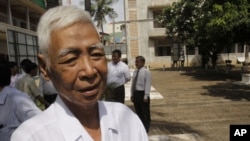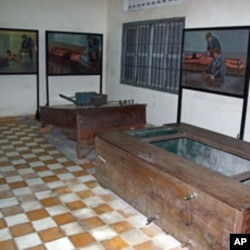Funeral preparations are underway for one of the most famous survivors of the brutal Khmer Rouge government. Cambodian painter Vann Nath passed away Monday after a long illness. He was 66 years old.
Vann Nath could easily have been one of the more than 12,000 Cambodians killed at the notorious Khmer Rouge prison, S-21. Instead, his gift of painting served as a gift of life. His jailers spared him to paint portraits of Pol Pot, the Khmer Rouge leader.
Vann Nath was one of only seven survivors to leave the prison when Vietnamese forces pushed the Khmer Rouge from power in 1979. He spent the rest of his life painting, speaking and writing about the abuses that took place there.
Youk Chhang, the director of the Documentation Center of Cambodia, got to know Vann Nath while collecting evidence for the U.N.-backed Khmer Rouge tribunal.
“He presented the strength of the Cambodian genocide survivor. He was a witness of history. That is Vann Nath,” Youk Chhang said after learning of the painter's death.
Listen to Kate's full interview with Youk Chhang:
In the tribunal's first case, the former prisoner testified against Kaing Kek Euv, or Duch, the S-21 chief who oversaw his torture.
Youk Chhang said he thinks Vann Nath found a sense of peace by testifying.
“How can you be silent? Especially when you’ve been dehumanized. More than anything else, as a human being, you want to become a person. I think that’s what Vann Nath wants the most. To become a free man. To become a person.”
Vann Nath’s 1998 memoir, A Cambodian Prison Portrait: One Year in the Khmer Rouge's S-21 Prison, is the only written account by a survivor of the prison. His book and paintings of bloody, tortured scenes from S-21 are visceral reminders of one of the most lethal regimes of the 20th century. Nearly two million people died under the Khmer Rouge, as it purged the population of anyone perceived a threat to its Communist, agrarian utopia.
Vann Nath’s paintings have helped Cambodians reconstruct their memory in a precise way, so that they can deal with the past, Youk Chhang said.
“You know, when you talk about justice, you talk about the court. When you talk about prevention, you talk about education, teaching the younger generation. But when it comes to healing, you need art,” he said.
Vann Nath grew up in Battambang, in northwestern Cambodia. Before being arrested by the Khmer Rouge, he made a living as a sign painter.
Sopheap Pich, a Cambodian-American artist who left Cambodia after the fall of the Khmer Rouge and has since returned to Phnom Penh, said he was proud to have worked with Vann Nath.
Listen to Kate's full interview with Sopheap Pich:
“I admire him for his sincerity, his honesty and his sort-of unwavering, I suppose one could say, attitude to not paint things just for the commercial market.”
That’s a rarity in Cambodia, where markets are filled with replicas of idyllic orange sunsets over green rice fields, traditional dancers and the famed Angkor Wat temple. Pich said Vann Nath was interested in capturing the true light of the day.
“I remember being in his studio quite recently and he was talking about, ‘Oh I paint this color, I paint this kind of light because I want to express that this took place at 3:00 PM and not 1:00 PM.’ So he was very interested in color and form. And I think this is where the pleasures of painting that is very much in him,” Pich said.
As true to the day’s light, Vann Nath was true in his own nature.
“Publicly and privately he is the same person. This in one thing I admire about many of the older generation artists of Cambodia," Pich noted. "When you spend time, he’s the same. He’s generous, he’s kind, he’s open, he’s energetic.”
That energy carries on in Cambodia’s young artists who, Pich said, will paint their own version of Cambodian history.
Until then, there is still one unfinished chapter. Duch was sentenced to 30 years in prison last year for war crimes and crimes against humanity. But the four surviving Khmer Rouge leaders charged with genocide have yet to go to trial. They are expected to stand before the court next year.











